MODULE 4: Assessing Tribal Members’ Needs
ENHANCING AND IMPLEMENTING HOMEOWNERSHIP PROGRAMS IN NATIVE COMMUNITIES
Assessing Tribal Members’ Needs
Assessing Tribal Members’ Needs
In starting our discussion on needs assessments, we will first define what a needs assessment is, and discuss why needs assessments are important.
What is a housing needs assessment?
A community housing needs assessment is an in-depth housing market analysis that carefully examines the area’s supply and demand for housing to determine the existing and future needs for shelter.
What do you think of this definition? Do you think it’s accurate? Does it capture what you need for your work? Should we add anything to it?
Why are needs assessments important?
Often, when we start planning for homeownership projects, we assume that we know what is needed in our communities. Because we work closely with clients in the communities we serve and may be community members ourselves, we may assume that we already know what the community wants or needs and believe that we can develop homeownership programming based on our experience. While this experience is valuable, it cannot replace a thorough assessment of the homeownership needs of our tribal members. A needs assessment can validate our assumptions, or it may identify different tribal member needs. Needs assessments can help steer the overall direction of our projects and developments, as well as help us fine-tune the details of potential projects. A needs assessment may show, for example, that we should be developing three-bedroom units rather than two-bedroom units, or that tribal members would prefer a certain location for a new subdivision or neighborhood.
While we may think that we don’t have the time or resources to conduct a needs assessment, by clarifying what your community wants, needs, and can afford, a needs assessment can save valuable time and resources in the long run. Despite the importance and value of needs assessments, we often skip this step, moving right into other phases of project development. Why do we skip the assessment?
|
WHY DO WE SKIP THE NEEDS ASSESSMENT? |
HOW WOULD WE ADDRESS THIS? |
|
It’s too expensive. |
It may be possible to conduct the assessment in house, collaborate with a university or other partner that won’t charge for their services, or access grant funding to cover the cost of the assessment. |
|
We don’t have time – we need to get going. |
Assessments can save time in the long run and are worth the short-term investment, if they can provide key data to ensure that the project is effectively meeting community needs. |
|
We know what the community needs. |
It is helpful to test and validate what we already know. Our assumptions may be incorrect, and we don’t want to go down the wrong path. |
|
We already did one. |
When was the previous assessment conducted? Is the data still accurate? Does it need to be updated? |
|
We are worried about confidentiality. |
It is possible to keep respondents’ information confidential. |
|
We do a lot of surveys and people won’t respond. |
It might be helpful to consider incentives, and think through the best way to distribute the survey (on-line, social media, by mail, at events). |
How Will You Gather Information about the Needs in Your Community?
How Will You Gather Information about the Needs in Your Community?
There are different ways you can gather information about the needs in your communities. These include:
-
◉Surveys
-
◉Focus groups
-
◉Interviews
-
◉Targeted outreach to specific groups (such as elders and youth)
-
◉Review of secondary data
What Makes a Successful Survey?
What Makes a Successful Survey?
Many of us have worked with surveys – either taking them, or conducting them, or both. Based on your experience, what makes a successful survey? And what should we avoid?
-
◉Clarify what you want to know. This will help ensure that you’re asking the right questions. You may want to get a general sense of who is interested in homeownership, for example, and some key design features they’d like to see, and then follow up at a later time on information that’s more sensitive, like income or credit scores.
-
◉Don’t ask too many questions. Often, having too many questions will cause respondents to stop answering questions before they’ve completed the full survey. It’s important to make sure every question is necessary – what are you learning from it?
-
◉Determine who you want to hear from. When focusing on homeownership, who are your potential homebuyers? Often we think of families on the Housing waiting list. Who else could be a potential homebuyer? Families with children in school, or HeadStart? Tribal employees? Families who are living away from the community but who would move home if there were homeownership opportunities?
-
◉Determine how you will collect information. What is the best way to reach tribal members? Email, regular mail, social media? Would it make sense to set up tables at big community events, or at key locations (like grocery stores)? Will respondents feel comfortable with a hard copy survey, or an on-line survey? Would it make sense to use of a combination of these methods?
-
◉Clarify how many respondents you’d like to hear from. This will impact your outreach efforts and how long your survey will be open. The more respondents you’d like, the more time and effort you’ll need to put into reaching out to them.
-
◉Determine who you might partner with to conduct your assessment. Potential partners include colleges and universities, consultants, nonprofit organizations, planning districts, and other tribal departments.
Incentives: Encouraging Community Members to Provide Their Input
Incentives: Encouraging Community Members to Provide Their Input
Often, the success of a survey can be impacted by incentives. Let’s take a look at what incentives have been effective in your community.
What incentives have been effective in your community?
5 Tips for Conducting Successful Tribal Needs Assessment Projects
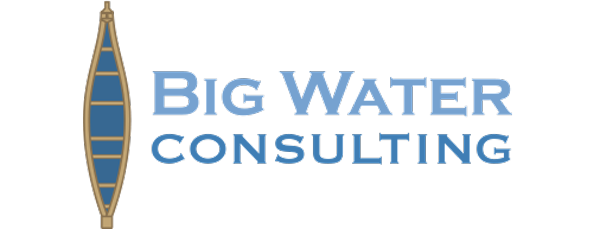 HELPFUL HINTS
HELPFUL HINTS
5 Tips for Conducting Successful Tribal Needs Assessment Projects
Provided by Big Water Consulting
- Without tribal support, this is just another survey. Community-wide needs assessment projects often address the data needs of a wide range of programs and depend upon efficient and timely assistance from various tribal departments, including human resources, communications, IT, finance and enrollment, etc. Commitment from tribal stakeholders, including leadership and an array of tribal programs, is critical to mobilizing vital tribal resources. Tribal support is also essential to get community buy-in and distinguish this tribal survey from the steady stream of others targeting tribal households.
- Be thorough, but don’t be greedy. Strike a balance between the desire to accommodate data requests from various tribal stakeholders and the practical necessity of limiting the amount of time it takes each community member to complete the questionnaire. To arrive at a thorough yet succinct survey, be sure to set common objectives and priorities among stakeholders during the survey design phase.
- An informed community is a cooperative community. Explain the purpose of the project through community events and all available communication channels to let the community know this effort is “by the tribe, for the tribe.” Don’t overlook the power of word-of-mouth: all field staff are ambassadors of the project and should be able to confidently explain the purpose of the project. An informative door hanger and a reasonable incentive that is easily used locally or reflects cultural values can help encourage community participation and increase response rates. At project closure, don’t forget to share the results and decisions with the community to demonstrate that their voice was heard and their participation is valued.
- A dedicated local team is the key to success. All data flows through the field staff: survey respondents provide honest and complete responses to field staff whom they trust and with whom they feel comfortable. Locally hired field staff should grasp the technical skills required for efficient data collection, as well as the art of effectively engaging with community members. As the local team lead, the survey manager must master project and personnel management, lead field staff through project hurdles, and be accountable for the team’s productivity.
- Monitor incoming data quality to avoid post- collection surprises. Review of incoming data should start early in the data collection phase. Identifying data quality issues, such as missing data or potential outliers, allows the survey manager to train or counsel field staff before additional errors pile up. Addressing data quality issues alongside the field data collection operation makes the data analysis and reporting processes more efficient.
Big Water Consulting is a consulting firm located in Seattle, Washington, which specializes in helping tribal, governmental, and nonprofit clients collect, analyze, manage, share, and act on relevant data. Over the past six years, Big Water has conducted over 20 tribal needs assessments or studies for tribal clients in Alaska and California and throughout the Northwest, Southwest, Great Lakes, and Northern Plains regions.
How Does the Needs Assessment Inform Homeownership Program Design?
How Does the Needs Assessment Inform Homeownership Program Design?
As we’ve discussed, one of the main reasons for conducting the needs assessment is to collect information that will inform your program design. How does this happen?
Let’s take a look at some sample needs assessment findings and how they can impact your homeownership program. For this exercise, we’ll take a look at the data from the Yankton Sioux Tribe Housing and Homeownership Needs Assessment on the following pages. This information was collected through a community survey, conducted by Big Water Consulting with support from the South Dakota Housing Development Authority and the South Dakota Native Homeownership Coalition.
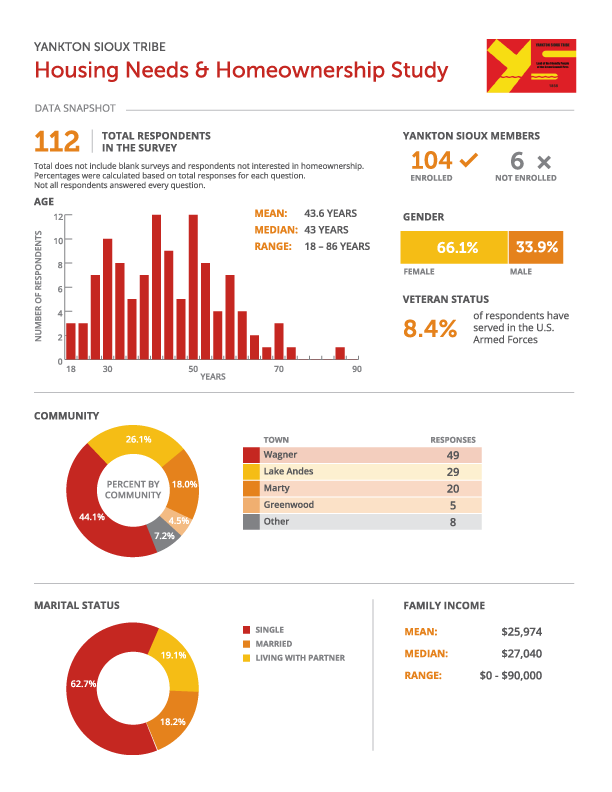
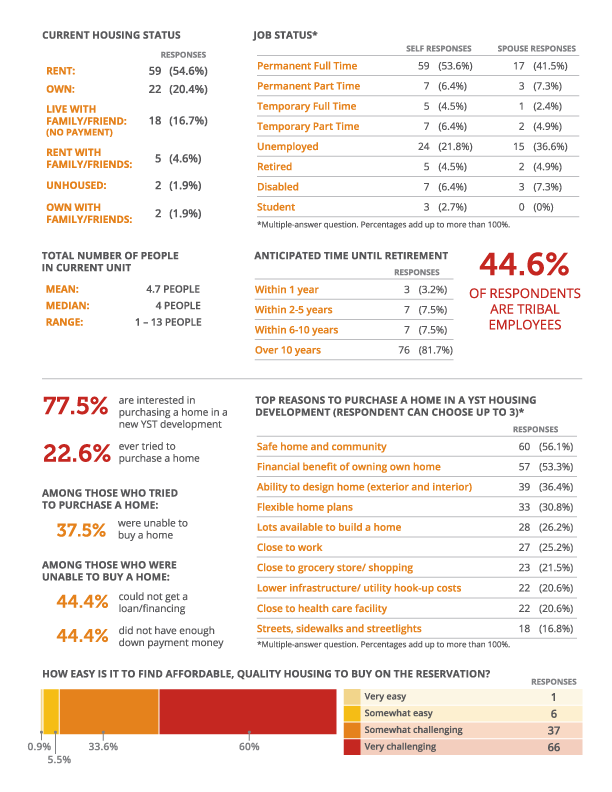
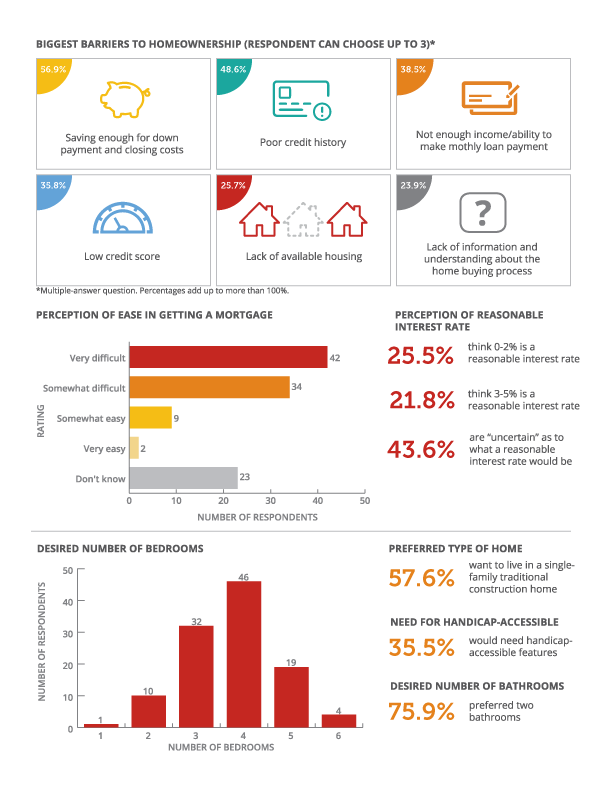
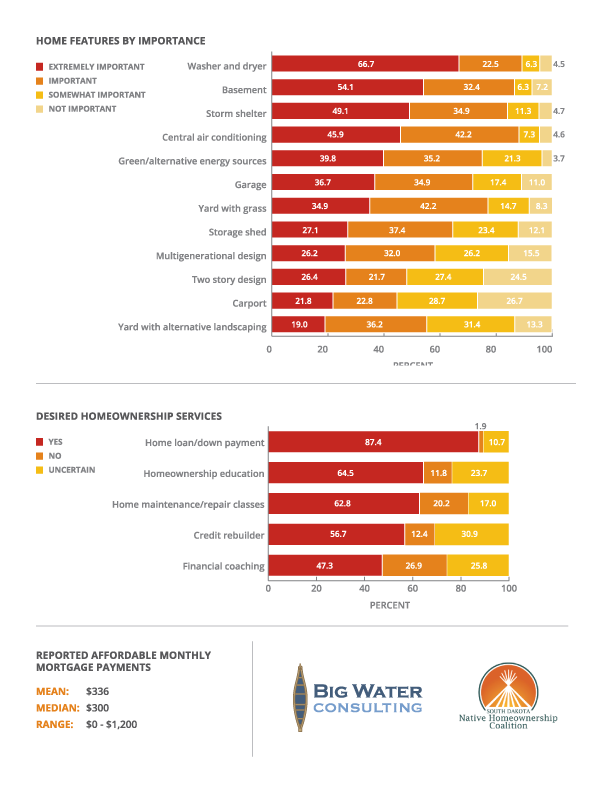
Based on the information we just reviewed, answer the following questions about homeownership program design:


